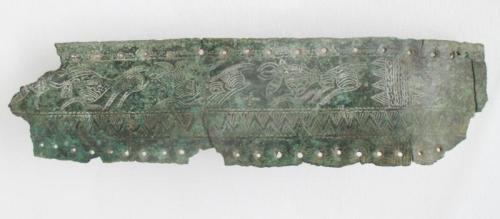
Fragment of a Repurposed Belt with Animal Frieze
On this preserved metal plaque, a series of abstracted quadrupeds move to the left. Comparable objects suggest that the animals may represent goats. Their horns alternate between short and curving inwards, and long and moving outwards. Each animal has a unique fur pattern engraved in lines or dots. Between each animal there is a plus symbol created from short vertical and horizontal bands. A design element—a pillar with three vertical flutes, half-moon bands, and triangular pendants—separates one of the visible animals from the others, but it may have once indicated a midway point on the object. The top of the image is bordered by three parallel lines, and a wider band with a zigzag pattern appears below.
This object has been repurposed into a belt, identifiable by the series of punctured holes at the top and bottom. The bottom holes were punctured through the remnants of what was the second register of animals, their horns still visible. Other examples of repurposed plaques are known.
Like another object in the Menil Collection (1984-28 DJ), this piece is best identified stylistically as Transcaucasian. Produced by people within the areas of modern Armenia, Azerbaijan, Georgia, and nearby regions, the thin metal plaques were created from the 9th to 8th centuries BCE. Metalwork, particularly copper alloy objects using ore from the Zagros mountains, was a main product of the region.

